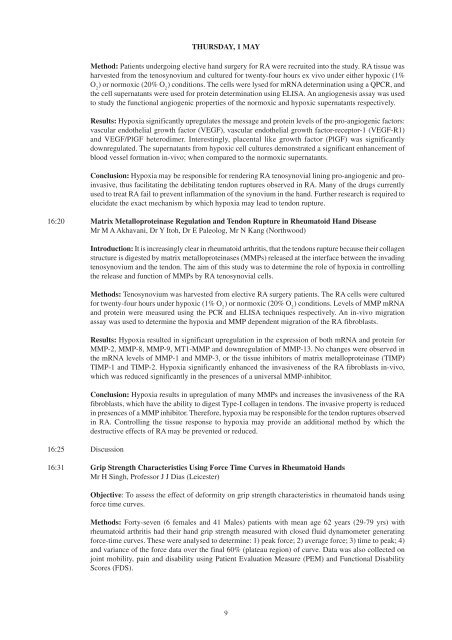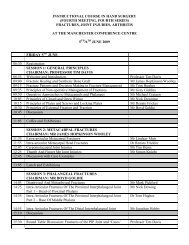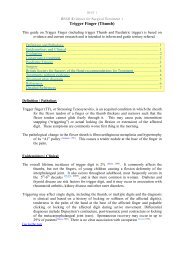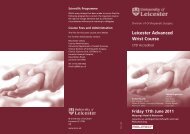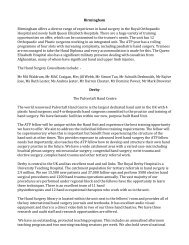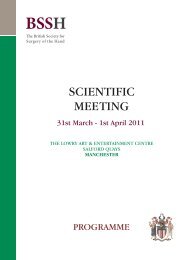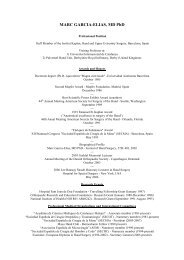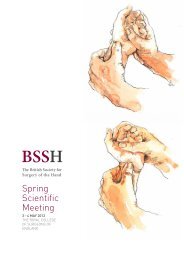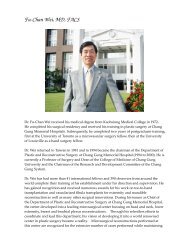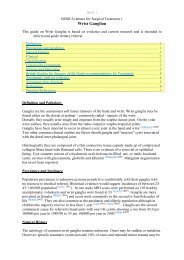here - The British Society for Surgery of the Hand
here - The British Society for Surgery of the Hand
here - The British Society for Surgery of the Hand
You also want an ePaper? Increase the reach of your titles
YUMPU automatically turns print PDFs into web optimized ePapers that Google loves.
Method: Patients undergoing elective hand surgery <strong>for</strong> RA were recruited into <strong>the</strong> study. RA tissue was<br />
harvested from <strong>the</strong> tenosynovium and cultured <strong>for</strong> twenty-four hours ex vivo under ei<strong>the</strong>r hypoxic (1%<br />
O 2<br />
) or normoxic (20% O 2<br />
) conditions. <strong>The</strong> cells were lysed <strong>for</strong> mRNA determination using a QPCR, and<br />
<strong>the</strong> cell supernatants were used <strong>for</strong> protein determination using ELISA. An angiogenesis assay was used<br />
to study <strong>the</strong> functional angiogenic properties <strong>of</strong> <strong>the</strong> normoxic and hypoxic supernatants respectively.<br />
Results: Hypoxia significantly upregulates <strong>the</strong> message and protein levels <strong>of</strong> <strong>the</strong> pro-angiogenic factors:<br />
vascular endo<strong>the</strong>lial growth factor (VEGF), vascular endo<strong>the</strong>lial growth factor-receptor-1 (VEGF-R1)<br />
and VEGF/PlGF heterodimer. Interestingly, placental like growth factor (PlGF) was significantly<br />
downregulated. <strong>The</strong> supernatants from hypoxic cell cultures demonstrated a significant enhancement <strong>of</strong><br />
blood vessel <strong>for</strong>mation in-vivo; when compared to <strong>the</strong> normoxic supernatants.<br />
Conclusion: Hypoxia may be responsible <strong>for</strong> rendering RA tenosynovial lining pro-angiogenic and proinvasive,<br />
thus facilitating <strong>the</strong> debilitating tendon ruptures observed in RA. Many <strong>of</strong> <strong>the</strong> drugs currently<br />
used to treat RA fail to prevent inflammation <strong>of</strong> <strong>the</strong> synovium in <strong>the</strong> hand. Fur<strong>the</strong>r research is required to<br />
elucidate <strong>the</strong> exact mechanism by which hypoxia may lead to tendon rupture.<br />
16:20 Matrix Metalloproteinase Regulation and Tendon Rupture in Rheumatoid <strong>Hand</strong> Disease<br />
Mr M A Akhavani, Dr Y Itoh, Dr E Paleolog, Mr N Kang (Northwood)<br />
16:25 Discussion<br />
THURSDAY, 1 MAY<br />
Introduction: It is increasingly clear in rheumatoid arthritis, that <strong>the</strong> tendons rupture because <strong>the</strong>ir collagen<br />
structure is digested by matrix metalloproteinases (MMPs) released at <strong>the</strong> interface between <strong>the</strong> invading<br />
tenosynovium and <strong>the</strong> tendon. <strong>The</strong> aim <strong>of</strong> this study was to determine <strong>the</strong> role <strong>of</strong> hypoxia in controlling<br />
<strong>the</strong> release and function <strong>of</strong> MMPs by RA tenosynovial cells.<br />
Methods: Tenosynovium was harvested from elective RA surgery patients. <strong>The</strong> RA cells were cultured<br />
<strong>for</strong> twenty-four hours under hypoxic (1% O 2<br />
) or normoxic (20% O 2<br />
) conditions. Levels <strong>of</strong> MMP mRNA<br />
and protein were measured using <strong>the</strong> PCR and ELISA techniques respectively. An in-vivo migration<br />
assay was used to determine <strong>the</strong> hypoxia and MMP dependent migration <strong>of</strong> <strong>the</strong> RA fibroblasts.<br />
Results: Hypoxia resulted in significant upregulation in <strong>the</strong> expression <strong>of</strong> both mRNA and protein <strong>for</strong><br />
MMP-2, MMP-8, MMP-9, MT1-MMP and downregulation <strong>of</strong> MMP-13. No changes were observed in<br />
<strong>the</strong> mRNA levels <strong>of</strong> MMP-1 and MMP-3, or <strong>the</strong> tissue inhibitors <strong>of</strong> matrix metalloproteinase (TIMP)<br />
TIMP-1 and TIMP-2. Hypoxia significantly enhanced <strong>the</strong> invasiveness <strong>of</strong> <strong>the</strong> RA fibroblasts in-vivo,<br />
which was reduced significantly in <strong>the</strong> presences <strong>of</strong> a universal MMP-inhibitor.<br />
Conclusion: Hypoxia results in upregulation <strong>of</strong> many MMPs and increases <strong>the</strong> invasiveness <strong>of</strong> <strong>the</strong> RA<br />
fibroblasts, which have <strong>the</strong> ability to digest Type-I collagen in tendons. <strong>The</strong> invasive property is reduced<br />
in presences <strong>of</strong> a MMP inhibitor. T<strong>here</strong><strong>for</strong>e, hypoxia may be responsible <strong>for</strong> <strong>the</strong> tendon ruptures observed<br />
in RA. Controlling <strong>the</strong> tissue response to hypoxia may provide an additional method by which <strong>the</strong><br />
destructive effects <strong>of</strong> RA may be prevented or reduced.<br />
16:31 Grip Strength Characteristics Using Force Time Curves in Rheumatoid <strong>Hand</strong>s<br />
Mr H Singh, Pr<strong>of</strong>essor J J Dias (Leicester)<br />
Objective: To assess <strong>the</strong> effect <strong>of</strong> de<strong>for</strong>mity on grip strength characteristics in rheumatoid hands using<br />
<strong>for</strong>ce time curves.<br />
Methods: Forty-seven (6 females and 41 Males) patients with mean age 62 years (29-79 yrs) with<br />
rheumatoid arthritis had <strong>the</strong>ir hand grip strength measured with closed fluid dynamometer generating<br />
<strong>for</strong>ce-time curves. <strong>The</strong>se were analysed to determine: 1) peak <strong>for</strong>ce; 2) average <strong>for</strong>ce; 3) time to peak; 4)<br />
and variance <strong>of</strong> <strong>the</strong> <strong>for</strong>ce data over <strong>the</strong> final 60% (plateau region) <strong>of</strong> curve. Data was also collected on<br />
joint mobility, pain and disability using Patient Evaluation Measure (PEM) and Functional Disability<br />
Scores (FDS).<br />
9


